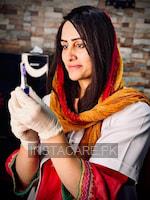Warts - Symptoms, Risk factors and Treatment
Last Updated On Sunday, December 14, 2025
Warts in Urdu
مسے چھوٹے ابھرے ہوئے، کھردرے، دانے دار جلد ہوتے ہیں جو زیادہ تر ہاتھوں میں ہوتے ہیں۔ تاہم، وہ جسم پر کہیں بھی پیدا ہوسکتے ہیں. جننانگ کے علاقے میں پائے جانے والے جننانگ مسے کہلاتے ہیں، جو سروائیکل کینسر کے امکانات کو بڑھاتے ہیں۔ وہ انسانی پیپیلوما وائرس نامی وائرس کی وجہ سے ہوتے ہیں۔ مسے تکلیف دہ نہیں ہوتے یا پریشان کن علامات کا سبب بنتے ہیں، لیکن یہ شرمندگی اور کاسمیٹک خدشات کا باعث بن سکتے ہیں۔ مزید یہ کہ وہ متعدی ہیں- یعنی چھونے سے پھیلتے ہیں۔ لہذا، آپ کو ان کو چھونے اور کھرچنے پر پابندی لگانی چاہیے۔ آپ کے وائرس سے متاثر ہونے کے بعد آپ کی جلد پر مسسا بننے میں دو سے چھ ماہ لگ سکتے ہیں۔
Warts in English
Warts are small raised, bumpy, grainy skin growths that occur mostly in the hands. However, they can arise anywhere on the body. Ones that occur in the genital region are called genital warts, which raise the chances of cervical cancer. They occur due to a virus called human papillomavirus. Warts are not painful or cause bothering symptoms, but they may lead to embarrassment and cosmetic concerns. Moreover, they are contagious- means spread through touch. Therefore, you should restrict touching and scratching them. A wart may take two to six months to develop on your skin after you have been exposed to the virus.
Causes
The main cause of warts is the virus known as the human papillomavirus. It has more than 150 strains. However, not all of them cause warts. Getting exposed to it can cause warts because it is contagious. Some types of human papillomaviruses spread through sexual contact, whereas, others spread through sharing of personal items like towels, brushes, and cosmetics. It may also spread through broken skin and nail-biting. However, exposure to it does not guarantee the development of wart because every person’s immune system acts differently.
Types
There are different types of warts which can be classified as;
Common warts
Common warts are the ones that appear on hands and fingers. They may have the following characteristics;
- Small
- Fleshy
- Grainy bumps
- Flesh-colored, white, pink, or tan
- Rough to the touch
- Sprinkled with black small pinpoint that is clotted blood vessels
Plantar warts
Plantar warts appear on the feet. They do not protrude out of the skin. Instead, they grow inside it and are surrounded by thick skin. They can hinder your walking.
Flat warts
They are the ones that develop on the face, arm, and thigh. They are quite small and not easy to notice, having a pink, slightly yellow, or brownish color.
Filiform warts
Filiform warts appear on the face, near the mouth, on the nose, near the chin or neck. They have the same colour, that of skin.
Periungual warts
This type of wart grows under your toenails or fingernails. They can become painful and may also affect nail growth.
Risk factors
People who have a weakened immune system are at risk of developing warts upon exposure. The immune system may be weakened due to any of the following reasons.
- Malignancies and chemotherapy for their treatment
- Having a disease that lowers immunity like AIDS
- Children because their immune system is not well developed as compared to adults
- Having a recent organ transplant
- Taking immunosuppressants for a long time like prednisolone or azathioprine.
A person may need to take corticosteroids for various reasons like asthma and inflammation, which however does lower your immunity. Therefore, when you take it, avoid going to crowded places and getting exposed to infected people.
Prevention
Avoid direct exposure with warts. It includes your own too. Do not touch them repeatedly.
Do not scratch or pick your warts. Doing that spreads them from one person to another.
Do not use the same nail clipper for diseased and healthy nails. Keep separate ones for both. When you use the same nail clipper for both, the diseased one can easily infect the healthy ones too. Therefore you need to be cautious about it.
Do not bite your nails because the breakage of the skin can become an entrance for a virus.
Maintain hygiene. Groom your hands and nails carefully. Avoid clipping or shaving the areas having warts.
After getting exposed to it, wash your hands for at least 20 seconds with soap and water.
Conclusion
Warts are small raised, bumpy, grainy skin growths that occur mostly in the hands. However, they can arise anywhere on the body. Ones that occur in the genital region are called genital warts, which raise the chances of cervical cancer. They occur due to a virus called human papillomavirus. Warts are not painful or cause bothering symptoms, but they may lead to embarrassment and low self-esteem. Moreover, they are contagious- means spread through touch.
Frequently Asked Questions
Warts meaning in urdu is Massa مسا.
Warts are caused by the human papillomavirus (HPV). The virus is quite common and has more than 150 types, but only a few cause warts on the skin. Warts are a type of skin infection caused by the human papillomavirus (HPV). The infection causes rough, skin-colored bumps to form on the skin. Viruses called human papillomavirus (HPV) cause warts. It is easier to catch a virus that causes warts when you have a cut or scrape on your skin.
Some natural remedies for wart removal include: Apple Cider Vinegar: Soak a cotton ball in apple cider vinegar and apply it to the wart. Cover it with a bandage and leave it on overnight. Aloe Vera: Apply aloe vera directly to the wart and cover with a bandage. Repeat twice a day until the wart is gone. Banana Peel: Rub the inside of a banana peel on the wart for a few minutes. Cover with a bandage and repeat twice a day until the wart is gone. Duct Tape: Cover the wart with duct tape and leave it on for a few days. Then, remove the tape and gently rub the wart with a pumice stone. Tea Tree Oil: Apply a few drops of tea tree oil directly to the wart. Cover with a bandage and repeat twice a day until the wart is gone.









